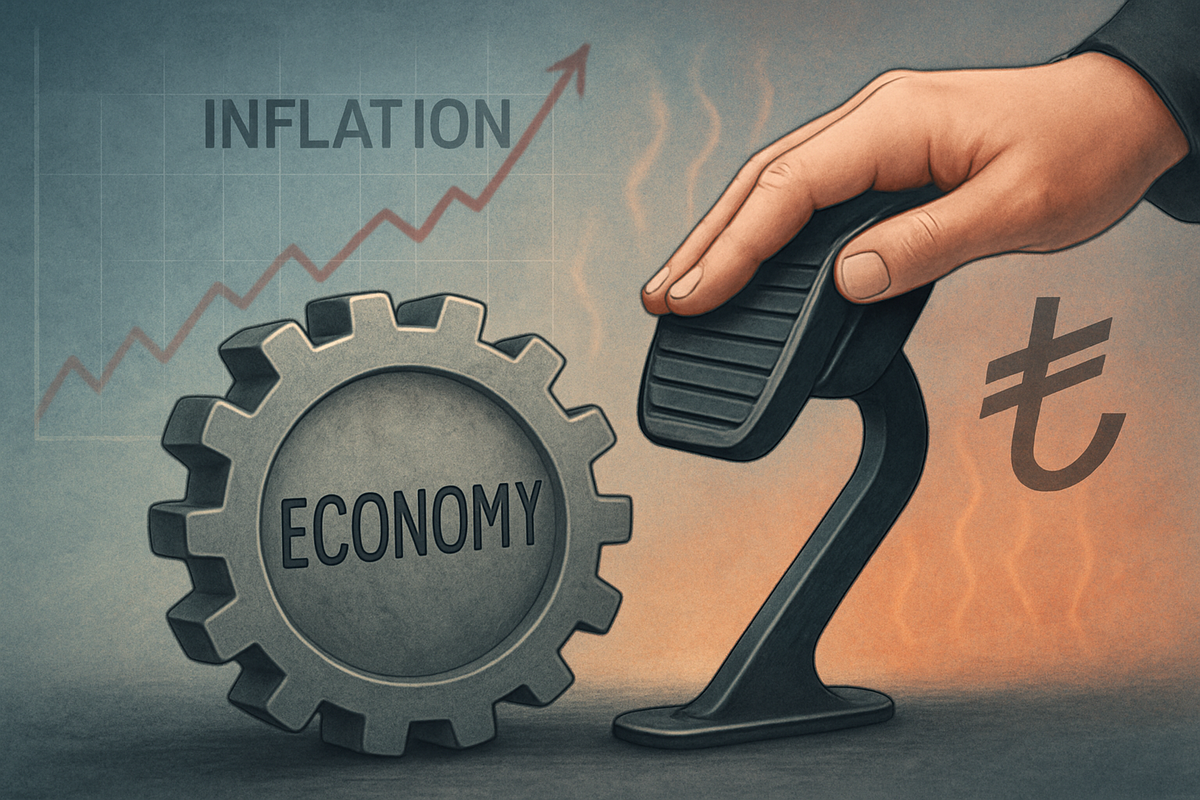
The Central Bank of the Republic of Turkey (CBRT) has signaled a notable and deliberate shift towards a more cautious stance in its easing cycle, a move that has immediately placed the Turkish Lira under renewed pressure. In October 2025, the CBRT opted for a smaller-than-anticipated interest rate cut, a clear indication that the fight against persistent inflation is taking precedence over aggressive monetary stimulus. This recalibration marks a critical juncture for the Turkish economy, as policymakers grapple with stubbornly high price pressures and a currency that continues to test historical lows.
This strategic pivot comes after a period of aggressive monetary tightening followed by a measured easing cycle, reflecting the central bank's delicate balancing act between fostering economic growth and achieving its paramount objective of price stability. The market's reaction, characterized by continued Lira depreciation, underscores the challenges ahead for Turkey as it navigates a complex economic landscape fraught with domestic inflationary concerns and global economic uncertainties.
The Measured Step: Decelerating the Easing Cycle
In its October 2025 Monetary Policy Committee (MPC) meeting, the Central Bank of Turkey announced a 100-basis-point reduction in its benchmark one-week repo rate, bringing it down to 39.5%. This decision marked a significant deceleration in the bank's easing cycle, which had seen more aggressive cuts of 250 basis points in September and 300 basis points in July of the same year. The cautious approach was a direct response to an unexpected resurgence of inflationary pressures, with Turkey's annual inflation rate climbing to 33.29% in September 2025, up from 32.95% in August, marking the first increase in 15 months and surpassing market expectations.
The timeline leading to this cautious shift is critical. From mid-2023 to March 2024, the CBRT embarked on an aggressive monetary tightening campaign, hiking the policy rate from 8.5% to a peak of 50% to combat inflation that had soared to over 75% by May 2024. A measured easing cycle then commenced in December 2024, with subsequent cuts bringing the rate to 40.5% by September 2025. However, the September inflation data served as a stark reminder of the persistent challenge, prompting the CBRT's MPC to adopt a more restrained approach in October. Key players, primarily the CBRT and its MPC, have consistently reiterated their commitment to maintaining a tight monetary policy until price stability is achieved, with a medium-term inflation target of 5%.
The initial market reaction to this cautious shift has been telling. The Turkish Lira continued to come under pressure, hitting a new record low of 41.9 per US dollar in October 2025, extending its year-to-date decline to approximately 18%. While the CBRT aims to anchor expectations, the Lira remains volatile, with the bank maintaining a presence in the foreign exchange market to manage its movement. Economists widely predict that the Lira will likely remain under pressure throughout 2025 due to ongoing inflationary concerns and geopolitical factors, with little expectation of significant appreciation.
Corporate Crossroads: Winners and Losers in a Cautious Environment
The CBRT's cautious monetary policy, coupled with persistent high inflation and a depreciating Lira, creates a challenging and selective environment for Turkish public companies and sectors. While some may find resilience or even opportunities, others face significant headwinds.
Companies heavily reliant on imported raw materials or intermediate goods will likely continue to struggle. The continuous depreciation of the Turkish Lira directly inflates their input costs, squeezing profit margins for manufacturing and production firms. Similarly, sectors sensitive to domestic consumer spending, such as retail, durable goods manufacturing, and automotive, will face weakened demand as high inflation eradicates purchasing power. Businesses with substantial foreign currency-denominated debt, without matching foreign currency revenues, are also vulnerable. The depreciating Lira significantly inflates their debt burden when converted to local currency, eroding earnings and straining balance sheets. For instance, Turkish Airlines (BIST: THYAO), while having foreign currency revenues, also has significant local currency liabilities, and a rapidly depreciating Lira could pose challenges if hedging benefits are outweighed. The real estate sector, exemplified by Emlak Konut Gayrimenkul Yatirim Ortakligi AS (IS:EKGYO), has already shown vulnerability, as high interest rates and cautious policy dampen demand and investment. Other firms in the leasing and factoring sector, like Destek Finans Faktoring AS (IS:DSTKF), and industrial conglomerates such as Haci Omer Sabanci Holding AS (IS:SAHOL), are also susceptible to high borrowing costs and reduced economic activity.
Conversely, certain sectors are better positioned to navigate or even benefit. Export-oriented companies with significant foreign currency revenues stand to gain, as a weaker Lira makes Turkish goods and services more competitive internationally. When foreign currency earnings are converted back to a weaker Lira, their profitability increases. The tourism industry also benefits from a depreciating Lira, making Turkey a more attractive and affordable destination for foreign visitors. Companies with strong pricing power and efficient supply chains, capable of passing on increased costs to consumers due to strong brands or essential products, will be more resilient to inflation. Furthermore, businesses with net foreign currency asset positions will see the Lira value of these assets increase with depreciation.
Wider Significance: A Return to Orthodoxy's Rocky Path
The CBRT's cautious monetary policy shift in October 2025 is more than just a rate adjustment; it signifies a pivotal recalibration towards economic orthodoxy, albeit on a challenging terrain. This move fits into broader global monetary trends where central banks, even in advanced economies, are wrestling with renewed inflation threats. For emerging markets (EMs), while many have gained resilience against external shocks, domestic inflation remains a primary driver of policy decisions. The CBRT's current stance aligns with a trend among EM central banks to prioritize price stability and rebuild credibility, even if the path is marked by persistent domestic inflationary challenges.
The ripple effects of this policy are substantial. For other emerging markets, a sustained commitment to disinflation in Turkey could enhance its credibility, potentially attracting capital inflows that might otherwise go elsewhere. Conversely, if inflation persists despite the cautious approach, it could deter investment, benefiting other more stable emerging economies. For major trading partners, particularly the European Union, increased confidence in Turkey's economic management could foster greater foreign direct investment and trade. However, continued Lira volatility due to stubborn inflation could negatively impact trade relations.
Domestically, the CBRT's commitment to its 5% medium-term inflation target signals a renewed dedication to conventional monetary policy. This implies future decisions will be highly data-dependent, with a readiness to tighten policy again if inflation deviates significantly. This approach, coupled with efforts to simplify macroprudential frameworks, aims to enhance market mechanisms and financial stability. Historically, Turkey has a rich history of monetary policy shifts and battles with inflation, notably the 2001 crisis that led to the CBRT's instrument independence and inflation-targeting framework. The aggressive tightening from May 2023 to March 2024, followed by the current cautious easing, represents a significant reversal towards conventional policy after a period of unconventional low-rate stances, drawing parallels to past attempts to stabilize the economy.
What Comes Next: Navigating the Disinflationary Tightrope
Following the cautious pivot in October 2025, the future trajectory for the Central Bank of Turkey's monetary policy, the Turkish Lira, and the broader economy remains a tightrope walk between disinflation and growth. Short-term possibilities indicate that the CBRT will be highly data-dependent, with future rate decisions hinging on incoming inflation figures. Further rate cuts are possible but will likely be smaller and more cautious, or the bank might even pause the easing cycle if inflationary pressures continue to build. The CBRT has explicitly stated its preparedness to tighten policy again if inflation significantly deviates from its interim targets. The Lira is expected to continue its managed depreciation, albeit potentially at a slower rate, but underlying inflation and external factors will likely maintain depreciation pressure.
In the long term, the CBRT's commitment to its 5% medium-term inflation target implies a sustained effort towards orthodox monetary policy. Achieving this will require consistent policy, potential reversals of the easing cycle if inflation remains stubborn, and a continuous rebuilding of credibility. Sustainable, balanced economic growth, projected by the IMF and World Bank for 2025, requires not only effective disinflation but also comprehensive structural reforms and robust fiscal discipline.
Strategic pivots are required across the board. The CBRT must maintain policy flexibility, be ready to adjust its easing cycle, and ensure clear, predictable communication to anchor inflation expectations. The government needs to reinforce fiscal discipline and pursue structural reforms to attract foreign direct investment. For businesses, robust risk management strategies against Lira volatility and a focus on productivity and export diversification will be crucial. Market opportunities may emerge in export-oriented sectors due to a weaker Lira, and potentially in equity or fixed-income markets if disinflation proves sustainable. However, persistent inflation, Lira volatility, potential capital outflows, and external headwinds pose significant challenges. Scenarios range from an optimistic outcome of successful disinflation and rebalancing to a pessimistic one where policy missteps lead to renewed instability and a potential currency crisis.
Wrap-Up: A Cautious Path Towards Stability
The Central Bank of Turkey's cautious monetary policy shift in October 2025 marks a critical turning point in its battle against inflation. The decision to decelerate the easing cycle, driven by an unexpected uptick in inflation, underscores a renewed and deliberate commitment to price stability. This pivot, while a challenging one, signals a move towards a more orthodox and data-dependent approach, aiming to rebuild credibility and anchor inflation expectations over the medium term.
Moving forward, the market will remain highly sensitive to incoming inflation data, CBRT communications, and economic growth indicators. The performance of the Turkish Lira (USD/TRY), particularly its stability, will serve as a key barometer of market sentiment and capital flows. Investors should also closely watch fiscal policy developments, progress on structural reforms, and geopolitical events, all of which can significantly impact Turkey's economic stability. While the path to sustained disinflation and economic rebalancing is fraught with challenges, this cautious shift indicates the CBRT's determination to steer the economy towards a more stable future. The lasting impact will ultimately depend on the consistency and effectiveness of these policies in the face of persistent domestic pressures and global uncertainties.
This content is intended for informational purposes only and is not financial advice





